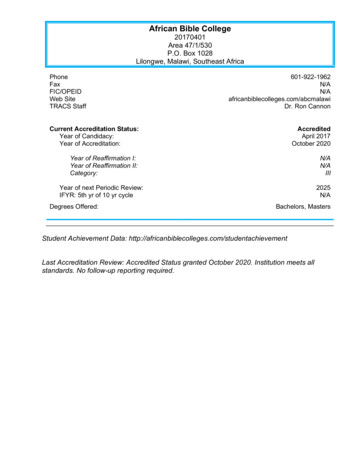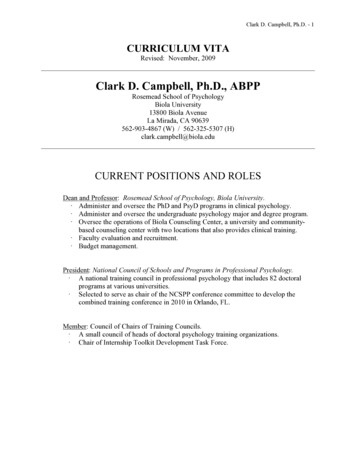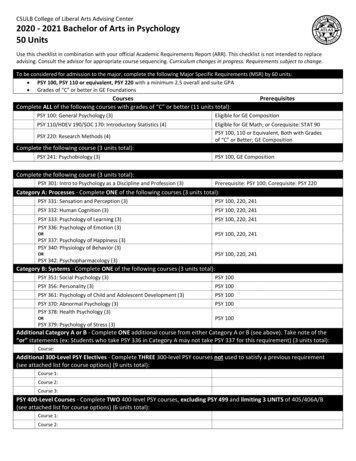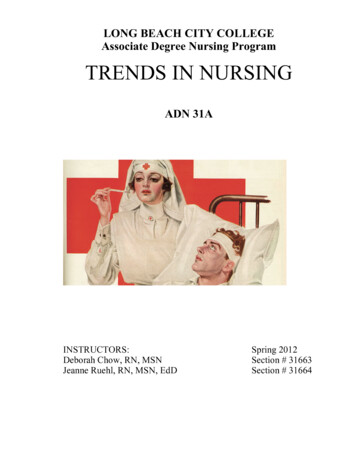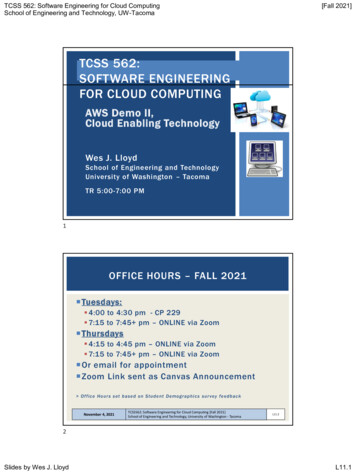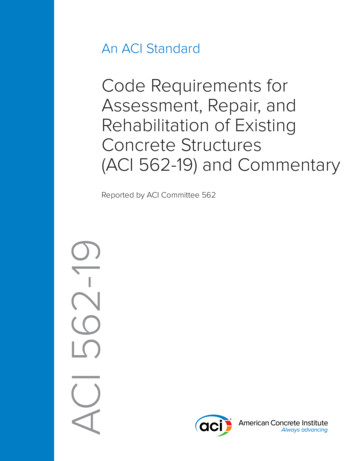
Transcription
An ACI StandardCode Requirements forAssessment, Repair, andRehabilitation of ExistingConcrete Structures(ACI 562-19) and CommentaryACI 562-19Reported by ACI Committee 562
First PrintingMay 2019ISBN: 978-1-64195-062-6Code Requirements for Assessment, Repair, and Rehabilitation of Existing Concrete Structures andCommentaryCopyright by the American Concrete Institute, Farmington Hills, MI. All rights reserved. This materialmay not be reproduced or copied, in whole or part, in any printed, mechanical, electronic, film, or otherdistribution and storage media, without the written consent of ACI.The technical committees responsible for ACI committee reports and standards strive to avoidambiguities, omissions, and errors in these documents. In spite of these efforts, the users of ACIdocuments occasionally find information or requirements that may be subject to more than oneinterpretation or may be incomplete or incorrect. Users who have suggestions for the improvement ofACI documents are requested to contact ACI via the errata website at px. Proper use of this document includes periodically checking for errata for the mostup-to-date revisions.ACI committee documents are intended for the use of individuals who are competent to evaluate thesignificance and limitations of its content and recommendations and who will accept responsibility forthe application of the material it contains. Individuals who use this publication in any way assume allrisk and accept total responsibility for the application and use of this information.All information in this publication is provided “as is” without warranty of any kind, either express orimplied, including but not limited to, the implied warranties of merchantability, fitness for a particularpurpose or non-infringement.ACI and its members disclaim liability for damages of any kind, including any special, indirect, incidental,or consequential damages, including without limitation, lost revenues or lost profits, which may resultfrom the use of this publication.It is the responsibility of the user of this document to establish health and safety practices appropriateto the specific circumstances involved with its use. ACI does not make any representations with regardto health and safety issues and the use of this document. The user must determine the applicability ofall regulatory limitations before applying the document and must comply with all applicable laws andregulations, including but not limited to, United States Occupational Safety and Health Administration(OSHA) health and safety standards.Participation by governmental representatives in the work of the American Concrete Institute and inthe development of Institute standards does not constitute governmental endorsement of ACI or thestandards that it develops.Order information: ACI documents are available in print, by download, through electronic subscription,or reprint, and may be obtained by contacting ACI.ACI codes, specifications, and practices are made available in the ACI Collection of Concrete Codes,Specifications, and Practices. The online subscription to the ACI Collection is always updated, andincludes current and historical versions of ACI’s codes and specifications (in both inch-pound and SIunits) plus new titles as they are published. The ACI Collection is also available as an eight-volume set ofbooks and a USB drive.American Concrete Institute38800 Country Club DriveFarmington Hills, MI 48331Phone: 1.248.848.3700Fax: 1.248.848.3701www.concrete.org
ACI 562-19Code Requirements for Assessment, Repair, andRehabilitation of Existing Concrete Structures (ACI 562-19)and CommentaryAn ACI StandardReported by ACI Committee 562Keith E. Kesner, ChairKevin Conroy, SecretaryVOTING MEMBERSTarek AlkhrdajiF. Michael BartlettRandal M. BeardEric L. EdelsonGarth J. FallisPaul E. GaudetteSusan IsbleGaur JohnsonLawrence F. KahnCarl J. LaroscheMing LiuJohn S. LundMarjorie M. LynchAntonio NanniGuillermo Alberto RiverosConstadino SirakisKyle D. StanishGene R. StevensJ. Gustavo TumialanDavid W. WhitmoreCONSULTING MEMBERSJames Peter BarlowPeter EmmonsFred R. GoodwinPaul L. KelleyTracy D. MarcotteJay H. PaulSUBCOMMITTEE MEMBERSJared BreweJeremiah D. FaslKip GattoAnton GueorguievPatrick D. MartinTimothy M. MontgomeryACI 562-19, “Code Requirements for Assessment, Repair andRehabilitation of Existing Concrete Structures,” was developedto provide design professionals a code for the assessment of thedamage and deterioration, and the design of appropriate repairand rehabilitation strategies. The code provides minimum requirements for assessment, repair, and rehabilitation of existing structural concrete buildings, members, systems and where applicable,nonbuilding structures. ACI 562-19 was specifically developed towork with the International Existing Building Code (IEBC) or to beadopted as a stand-alone code.Jose PachecoCONTENTSPREFACE, p. 3CHAPTER 1—GENERAL REQUIREMENTS, p. 51.1—General, p. 51.2—Criteria for the assessment and design of repair andrehabilitation of existing concrete structures, p. 61.3—Applicability of this code, p. 81.4—Administration, p. 101.5—Responsibilities of the licensed design professional,p. 111.6—Construction documents, p. 131.7—Preliminary assessment, p. 13Keywords: assessment; bond; corrosion; damage; durability; evaluation; existing structure; fiber-reinforced polymer (FRP); interface bond;licensed design professional; maintenance; rehabilitation; reliability; repair;strengthening.ACI 562-19 supersedes ACI 562-16, was adopted May 1, 2019, and was publishedMay 2019.Copyright 2019, American Concrete Institute.All rights reserved including rights of reproduction and use in any form or byany means, including the making of copies by any photo process, or by electronicor mechanical device, printed, written, or oral, or recording for sound or visualreproduction or for use in any knowledge or retrieval system or device, unlesspermission in writing is obtained from the copyright proprietors.1
2CODE REQUIREMENTS FOR ASSESSMENT, REPAIR, AND REHABILITATION OF EXISTING CONCRETE STRUCTURES (ACI 562-19)CHAPTER 2—NOTATION AND DEFINITIONS, p. 162.1—Notation, p. 162.2—Definitions, p. 17CHAPTER 3—REFERENCED STANDARDS, p. 24CHAPTER 4—CRITERIA WHEN USING THIS CODEWITH THE INTERNATIONAL EXISTING BUILDINGCODE (IEBC), p. 264.1—General, p. 264.2—Compliance method, p. 284.3—Potentially dangerous structural conditions, p. 284.4—Substantial structural damage, p. 294.5—Conditions of deterioration, faulty construction,or damage less than substantial structural damage withstrengthening, p. 294.6—Conditions of deterioration, faulty construction,or damage less than substantial structural damage withoutstrengthening, p. 314.7—Additions, p. 324.8—Alterations, p. 324.9—Change of occupancy, p. 32CHAPTER 5—LOADS, FACTORED LOADCOMBINATIONS, AND STRENGTH REDUCTIONFACTORS, p. 335.1—General, p. 335.2—Load factors and load combinations, p. 335.3—Strength reduction factors for rehabilitation design,p. 345.4—Strength reduction factors for assessment, p. 345.5—Additional load combinations for structures rehabilitated with external reinforcing systems, p. 35CHAPTER 6—ASSESSMENT, EVALUATION, ANDANALYSIS, p. 386.1—Structural assessment, p. 386.2—Investigation and structural evaluation, p. 386.3—Material properties, p. 396.4—Test methods to quantify material and member properties, p. 416.5—Structural analysis of existing structures, p. 456.6—Structural serviceability, p. 466.7—Structural analysis for repair design, p. 466.8—Strength evaluation by load testing, p. 47CHAPTER 7—DESIGN OF STRUCTURALREPAIRS, p. 497.1—General, p. 497.2—Strength and serviceability, p. 497.3—Behavior of repaired systems, p. 497.4—Interface bond of cementitious repair materials, p. 507.5—Materials, p. 537.6—Design and detailing considerations, p. 547.7—Repair using supplemental post-tensioning, p. 587.8—Repair using fiber-reinforced polymer (FRP)composites, p. 597.9—Performance under fire and elevated temperatures,p. 60CHAPTER 8—DURABILITY, p. 638.1—General, p. 638.2—Cover, p. 658.3—Cracks, p. 668.4—Corrosion and deterioration of reinforcement andmetallic embedments, p. 678.5—Surface treatments and coatings, p. 69CHAPTER 9—CONSTRUCTION, p. 709.1—General, p. 709.2—Stability and temporary shoring requirements, p. 709.3—Temporary conditions, p. 729.4—Environmental issues, p. 72CHAPTER 10—QUALITY ASSURANCE, p. 7310.1—General, p. 7310.2—Inspection, p. 7310.3—Testing of repair materials, p. 7510.4—Construction observations, p. 76CHAPTER 11—COMMENTARY REFERENCES, p. 77Authored documents, p. 82APPENDIX A—CRITERIA AS A STAND-ALONECODE, p. 85A.1—General, p. 85A.2—Design-basis code criteria, p. 85A.3—Potentially dangerous structural conditions, p. 87A.4—Substantial structural damage, p. 88A.5—Conditions of deterioration, faulty construction,or damage less than substantial structural damage withstrengthening, p. 89A.6—Conditions of deterioration, faulty construction,or damage less than substantial structural damage withoutstrengthening, p. 92A.7—Additions, p. 92A.8—Alterations, p. 92A.9—Change of occupancy, p. 93Key changes from ACI 562-16 to ACI 562-19:Summary of revisions, p. 94Major revisions, p. 94Minor revisions, p. 94American Concrete Institute Copyrighted Material—www.concrete.org
CODE REQUIREMENTS FOR ASSESSMENT, REPAIR, AND REHABILITATION OF EXISTING CONCRETE STRUCTURES (ACI 562-19) 3PREFACEThis code provides minimum requirements for assessment, repair, and rehabilitation of existing structural concrete buildings,members, systems and where applicable, nonbuilding structures. This code was developed by an ANSI-approved consensusprocess. This code can supplement the International Existing Building Code (IEBC), supplement the code governing existingstructures of an authority having jurisdiction, or act as a stand-alone code in a locality that has not adopted an existing-buildingcode. When this code is adopted as a stand-alone code, Appendix A should be used in place of Chapter 4.The Code is specifically written for use by a licensed design professional. This code provides minimum requirements forassessment, design and construction, or implementation of repairs and rehabilitation, including quality assurance requirements, for structural concrete in service. This code has no legal status unless it is adopted by the authority having jurisdiction.Where the code has not been adopted, it serves as a standard to provide minimum requirements for assessment, and designand construction of repair and rehabilitation of existing structural concrete. ACI 318 provides minimum requirements for thematerials, design, and detailing of structural concrete buildings and, where applicable, nonbuilding structures, and for newconstruction within existing structures where noted herein.Key changes from ACI 562-16 to ACI 562-19 include:(a) Text was added to simplify use of new materials that have the equivalent of an ICC-ES evaluation report in Chapter 1.(b) The requirements for the basis of design report were simplified in Chapter 1.(c) Requirements related to detailing of existing reinforcing steel in Chapter 4 have been clarified.(d) The commentary in Chapter 8 was updated to include a listing of exposure categories that may affect durability.American Concrete Institute Copyrighted Material—www.concrete.org
4CODE REQUIREMENTS FOR ASSESSMENT, REPAIR, AND REHABILITATION OF EXISTING CONCRETE STRUCTURES (ACI 562-19)THIS PAGE INTENTIONALLY LEFT BLANK.American Concrete Institute Copyrighted Material—www.concrete.org
CODE REQUIREMENTS FOR ASSESSMENT, REPAIR, AND REHABILITATION OF EXISTING CONCRETE STRUCTURES (ACI 562-19) CODECOMMENTARYCHAPTER 1—GENERAL REQUIREMENTSR1—GENERAL REQUIREMENTS51.1—General1.1.1 ACI 562, “Code Requirements for Assessment,Repair, and Rehabilitation of Existing Concrete Structures,”is hereafter referred to as “this Code.”R1.1—General1.1.2 Scope—This code shall apply to assessment, repair,and rehabilitation of existing concrete structures as:1. A code supplementing the International ExistingBuilding Code (IEBC)2. As part of a locally adopted code governing existingbuildings or structures3. Or as a stand-alone code for existing concrete structuresR1.1.2 This code defines assessment, design, constructionand durability requirements for repair and rehabilitation ofexisting concrete structures. Throughout this code, the term“structure” means an existing building, member, system,and, where applicable, nonbuilding structures where theconstruction is concrete or mixed construction with concreteand other materials.Chapter 4 provides assessment, repair, and rehabilitationcriteria if this code is used as a supplement to the International Existing Building Code (IEBC) for concrete membersand systems.Appendix A provides assessment, repair, and rehabilitationcriteria when this Code is adopted, including Appendix A, asa stand-alone code for repair of existing concrete structures.1.1.3 The intent of this Code is to safeguard the publicby providing minimum structural requirements for existingstructural concrete members, systems, and buildings.R1.1.3 The intent of this code is to address the safety ofexisting structures through assessment requirements thatdemonstrate an approximation of the structural reliabilityusing demand-capacity ratio limits of Chapter 4 or AppendixA and, if necessary as determined by the assessment, increasethe structural capacity by repair or rehabilitation.Unless prohibited by the authority having jurisdiction, ifan existing structure is shown to be potentially dangerous inaccordance with 4.3 or A.3, the structure should be rehabilitated using 4.3 or A.3.Using the demand-capacity ratio limits of 4.5.1 or A.5.1,repair of the existing structural concrete to its predeterioratedstate is permitted based on material properties specified inthe original construction (per Chapter 6), and substantiatedengineering principles of the original design. Where requirements of the original building code are appreciably changedin the current building code, the licensed design professionalmay consider using 4.5.2 or A.5.2.Beyond the restoration assessment requirements of4.5.1 and 4.5.3 or A.5.1 and A.5.3, the structural reliabilityprinciples of 4.5.2 or A.5.2 are permitted. These alternative requirements provide acceptable safety if the currentbuilding code demand exceeds the original building codedemand or if the regulations of the original building codeprovide an unacceptable level of structural reliability.1.1.4 All references in this code to the licensed designprofessional shall be understood to mean persons whopossess the knowledge, judgment, and skills to interpret andproperly use this code and are licensed in the jurisdictionwhere this code is being used. The licensed design professional for the project is responsible for, and in charge of, theassessment or rehabilitation design, or both.American Concrete Institute Copyrighted Material—www.concrete.org
6CODE REQUIREMENTS FOR ASSESSMENT, REPAIR, AND REHABILITATION OF EXISTING CONCRETE STRUCTURES (ACI 562-19)CODECOMMENTARY1.1.5 The requirements of this code are provided usingstrength design provisions for demands and capacities,unless otherwise noted.R1.1.5 When this code permits the original building coderegulations to be used and that code uses allowable stressdesign, the following should be considered: those provisionsshould be substituted for strength design as noted in 4.5.3or A.5.3; the licensed design professional is not required touse, but should consider using strength design provisions ofthis code as a check in the assessment of existing structuresoriginally designed with allowable stress methods.1.2—Criteria for the assessment and design ofrepair and rehabilitation of existing concretestructures1.2.1 The “existing building code” refers to the codeadopted by a jurisdiction that regulates existing buildings orstructures.R1.2—Criteria for the assessment and designof repair and rehabilitation of existing concretestructuresR1.2.1 The code governing existing buildings in theUnited States is commonly the IEBC developed by theInternational Code Council (ICC). The IEBC provides regulations for evaluations of damage and the limit for damage tobe repaired using the original building code.1.2.2 The “current building code” refers to the generalbuilding code adopted by a jurisdiction that regulates newbuilding design and construction.R1.2.2 The current building code establishes the designand construction regulations for new construction. Strengthdesign regulations of the current building code include:(a) Required strengths computed using combinations offactored loads (strength design demands)(b) Design strengths (capacities) based on testing of materials, members, and systems(c) Analytical methods used to calculate member andsystem capacity(d) Strength reduction factors, which have been established to be consistent with reliability indices used with thestrength design demandsThe load factors and strength reduction factors in thecurrent building code are obtained through rational designcode calibration procedures to achieve the targeted reliability indices which produce historically acceptable structural safety for new structures. The targeted reliabilityindices are generally based on past structural behavior, engineering experiences, costs and consequences of loss, amongother criteria. The resulting demand-capacity ratios for newstructures provide the limits that are not to be exceeded ifdesigning new construction, but these demand-capacity ratiolimits need not to be the same as those for existing structuresas noted in sections 4.5.2 and A.5.2.The general building code in the United States is usuallybased on the International Building Code (IBC) publishedby the ICC. Prior to 2015, Chapter 34 of the IBC includedprovisions for existing structures. For the design andconstruction of new concrete structures, the IBC and mostother older general building codes often reference ACI 318,Building Code Requirements for Structural Concrete andCommentary, with exceptions and additions.1.2.3 The “original building code” refers to the generalbuilding code applied by the authority having jurisdictionto the structure in question at the time the existing structurewas permitted for construction.R1.2.3 This definition of “original building code” is consistent with the building code in effect at the time of originalpermitted construction per the IEBC. In assessing existingstructures, the licensed design professional may need toconsider changes in the codes enforced by the local authorityAmerican Concrete Institute Copyrighted Material—www.concrete.org
CODE REQUIREMENTS FOR ASSESSMENT, REPAIR, AND REHABILITATION OF EXISTING CONCRETE STRUCTURES (ACI 562-19) CODE7COMMENTARYhaving jurisdiction for the structure from the time of the original design through the time of the completion of construction. For buildings with major alterations or additions, theoriginal building code should refer to the code in effect whenthe subject portion of the building was permitted, and differentportions of a building may have different original buildingcodes.Reference to design requirements of the original buildingcode should include: demands determined using eithernominal loads, load factors, and load combinations of theoriginal building code, or using allowable design loads andload combinations of the original building code; capacities determined using either strength design and reinforcement detailing provisions, and strength reduction factors ofthe original building code or using allowable stress designprovisions of the original building code; and constructionmaterials. Requirements for concrete design and construction include previous versions of ACI 318, concrete codespredating ACI 318, or concrete provisions within the original building code. A structural assessment using allowablestress design provisions of the original building code shouldbe coupled with an evaluation using current standards or thestrength design and reinforcement detailing provisions ofthis code to increase the understanding of structural behavior.For a structure constructed prior to the adoption of abuilding code, the licensed design professional shouldresearch available standards and practices in effect at thetime of construction. The Historic American EngineeringRecord, a program of the United States Park Service, hasinformation on construction and preservation of historicstructures (https://www.nps.gov/hdp/haer/).1.2.4 Design-basis code criteria1.2.4.1 The design-basis code criteria in this Code shallbe used to assess and design repairs of existing members,systems, and structures.R1.2.4 Design-basis code criteriaR1.2.4.1 The design-basis code criteria include requirements for assessment of the existing structure and for designwhen repairs are required based upon assessment results.If a jurisdiction has adopted the IEBC and ACI 562 isused, then the design-basis code criteria are based on theIEBC with supplemental requirements of this code forpotentially dangerous structural conditions, damage lessthan substantial structural damage, deterioration of concreteand reinforcement, faulty construction, serviceability issues,and durability of existing concrete.For substantial structural damage, additions, alterations,and changes in occupancy, the IEBC establishes limits towhich an assessment and design of repair and rehabilitation can occur in accordance with the original buildingcode. Above these limits, an assessment and design of therepair and rehabilitation is in accordance with the currentbuilding code. Current and original building code provisionsare supplemented by this code to address existing concretemembers, systems, and structures.Appendix A applies if a jurisdiction has not adopted theIEBC and has adopted this code. Appendix A of this code canprovide design-basis code criteria for potentially dangerousAmerican Concrete Institute Copyrighted Material—www.concrete.org
8CODE REQUIREMENTS FOR ASSESSMENT, REPAIR, AND REHABILITATION OF EXISTING CONCRETE STRUCTURES (ACI 562-19)CODECOMMENTARYstructural conditions, substantial structural damage, damageless than substantial structural damage, deterioration ofconcrete and reinforcement, faulty construction, additions,alternations, changes in occupancy, serviceability issues,and durability of existing concrete.1.2.4.2 Assessment and design-basis criteria and therequirements for applying these criteria are provided inChapter 4 and Appendix A. Chapter 4 applies if a jurisdiction has adopted the International Existing Building Code(IEBC) as the existing building code. Appendix A applies ifa jurisdiction has not adopted the IEBC or if a jurisdictionhas adopted this code.R1.2.4.2 Classifying the work category using criteria andrequirements of Chapter 4 or Appendix A defines the designbasis criteria, which is used to design the repair or rehabilitation work.1.2.4.3 Assessment criteria shall be used to classify thework and to establish the design-basis criteria.1.2.4.3.1 It shall be permitted to use the current buildingcode as the assessment criteria for all existing structures.R1.2.4.3.1 Use of the current building code for assessment criteria may result in a conservative assessment of anolder structure. The design professional should review use ofthe current building code with the Owner at the start of theproject (refer to R1.3.1).1.2.4.4 Design-basis criteria shall be used to establish theapplicable building code for repair and rehabilitation design.1.2.4.5 The current building code shall be the design-basiscode for new members and for connection of new membersto existing structures.1.2.4.5.1 The exceptions to 1.2.4.5 occur for the following:1) when seismic retrofits are designed using the alternatedesign criteria of ASCE 41, or 2) when new members areadded within the work area using the original building codeas the design-basis code criteria for the repair.R1.2.4.5.1 The performance-based criteria in ASCE 41may result in new member design that will not satisfy currentcode requirements for strength, stiffness, or detailing. Newconcrete members and reinforcement may be designed bythe original building code if integrated with the work arearepair construction of the existing structure when the repairdesign-basis criteria for the existing structure is the originalbuilding code. The detailing of these new members and theconnection of these members to the existing concrete shouldbe according to the current building code.1.3—Applicability of this code1.3.1 This code provides minimum requirements whenperforming an assessment, repair or rehabilitation designand remedial construction of the structural componentsof existing concrete structures, including buildings andnonbuilding structures.R1.3—Applicability of this codeR1.3.1 In typical U.S. practice, Owners are required tomaintain existing structures to prevent unsafe conditionsfrom occurring, or repair an existing structure when unsafeconditions are present. The minimum level of repair for anexisting building will typically address these unsafe andpotentially unsafe conditions.The licensed design professional is permitted to performassessment, design, and quality assurance activities thatexceed the minimum requirements of this Code. Considerations beyond the minimum requirements of this Code, suchas those for progressive collapse resistance, redundancy,or integrity provisions are permitted. Exceeding the codeminimum requirements is not a violation of this Code.1.3.1.1 Regulations of the current building code need notbe exceeded when assessing, designing repair and rehabilitation work, or installing remedial work of existing structures.American Concrete Institute Copyrighted Material—www.concrete.org
CODE REQUIREMENTS FOR ASSESSMENT, REPAIR, AND REHABILITATION OF EXISTING CONCRETE STRUCTURES (ACI 562-19) CODE9COMMENTARYThe Owner and the design professional should agreeon the intent of the repair and rehabilitation program anddesired outcome at the onset of the project. The desired repairoutcome may include consideration of the design service lifeof the repairs, structural reliability, serviceability considerations, and other factors. Due to the uncertain remainingservice life of existing structures and the technical requirements of repair construction, quality assurance and construction observations in excess of that required by generalbuilding code is commonly required. The desired outcomeof the repair and rehabilitation program, quality assurance,and construction observation requirements should be documented in the basis of design (Section 1.5.3).1.3.2 This Code is applicable to existing nonbuildingconcrete structures.1.3.3 FoundationsR1.3.2 Nonbuilding concrete structures can include, butare not limited to arches, tanks, reservoirs, bins and silos,blast- and impact-resistant structures, and chimneys.R1.3.3 Foundations1.3.3.1 This code shall apply to the assessment and repairor rehabilitation of existing structural concrete foundationmembers.R1.3.3.1 Foundation members and systems shouldinclude those constructed using plain or reinforced concreteincluding but not limited to spread footings, mat foundations, concrete piles, drilled piers, grade beams, pile and piercaps, and caissons embedded in the ground. The design andinstallation of new pilings fully embedded in the ground areregulated by the current building code. For repair of existingfoundation members and systems, the provisions of thiscode apply if not in conflict with the code governing existingbuilding. For the portions of concrete piling in air or water,or in soil not capable of providing adequate lateral restraintthroughout the piling to prevent buckling, the provisions ofthis code govern.1.3.4 Soil-supported slabs1.3.4.1 This code shall apply to the assessment and repairor rehabilitation of soil-supported structural slabs thattransmit vertical loads or lateral forces from the structureto the soil.1.3.5 Composite members1.3.5.1 This code shall apply to the assessment and repairor rehabilitation of the concrete portions of compositemembers.1.3.6 Precast and prestressed concrete1.3.6.1 The code shall apply to the assessment and repair orrehabilitation of structural precast and prestressed concretemembers, systems, and connections. The code shall apply tocladding transmitting vertical loads to supporting membersor lateral loads to diaphragms or bracing members.1.3.7 Nonstructural concreteR1.3.7 Nonstructural concreteAmerican Concrete Institute Copyrighted Material—www.concrete.org
10CODE REQUIREMENTS FOR ASSESSMENT, REPAIR, AND REHABILITATION OF EXISTING CONCRETE STRUCTURES (ACI 562-19)CODECOMMENTARY1.3.7.1 This code is not intended for repair of nonstructural concrete or for aesthetic improvements, except if failureof such repairs would result in an potentially dangerouscondition.R1.3.7.1 Where nonstructural concrete requires repair,that repair is not required to comply with or satisfy therequirements of this code. The licensed design professionaldesigning repairs to nonstructural concrete should considerthe consequence of repair failure to determine if there areprovisions of this code that are applicable.1.3.8 Seismic resistanceR1.3.8 Seismic resistance1.3.8.1 Evaluation of seismic resistance and design ofretrofit shall be in accordance with the code governingexisting buildings if one has been adopted or this code ifa code governing existing buildings has not been adopted.If using this code for evaluation of seismic resistance andretrofit design, ASCE/SEI 41 shall apply.R1.3.8.1 Provisions in Chapter 10 of ASCE/SEI 41 arebased on ACI 369.1-17, which provides specific guidanceon evaluation, repair and rehabilitation for existing concretestructures.1.3.8.2 If retrofit for seismic resistance is not required bythe code governing existing buildings or by this code, voluntary seismic retrofit shall
Building Code (IEBC) 2. As part of a locally adopted code governing existing buildings or structures 3. Or as a stand-alone code for existing concrete structures 1.1.3 The intent of this Code is to safeguard the public by providing minimum structural requirements for existing stru



